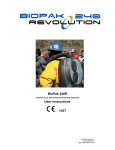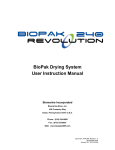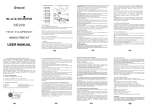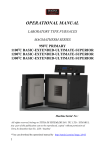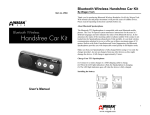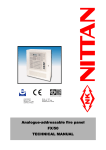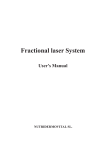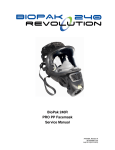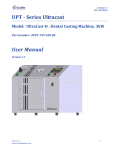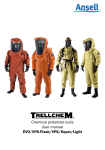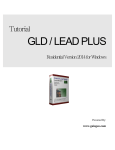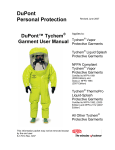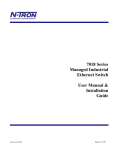Download Training Guide - BioPak 240 Revolution 4
Transcript
456 Creamery Way · Exton, PA 19341 · USA
BioPak 240R
Revolution
Training Guide
Effective Date: August 2013
Document Number: A47D274
Revision Level: C [ECO 9755]
Note: It shall be the responsibility of the Biomarine Training Manager to periodically review this guide and all
associated and referenced documentation to provide improvements and corrects where warranted.
BioPak 240R Revolution Training Guide
Table of Contents
Statement of Objectives
3
User Training Requirements
4
Benchman Training Requirements
5
Instructor Training Requirements
6
Training Guide Use
7
Training Session Outlines
8
Information and Description
BioPak 240R Use
BioPak 240R Turn-Around Maintenance
9
13
18
BioPak 240R Periodic Long-Term Maintenance
Benchman Training
User Training Quiz Answer Sheet
19
20
21
Benchman Training Quiz Answer Sheet
22
Training Completion
23
Factory Contacts
24
Appendix A: BioPak 240R Flow Diagram
25
Appendix B: Positive Pressure Versus Negative Pressure Diagram
26
A47D274 Rev. [ECO 9755]
August 2013
Page 2 of 26
BioPak 240R Revolution Training Guide
Statement of Objectives
The BioPak 240R respirator is designed to provide a breathing atmosphere to the user in situations that are
life-threatening and dangerous. Thus it is paramount that individual users and team users of the device
become technically proficient in the use, maintenance, function and support of the device before actually
donning such equipment. Biomarine’s objective is to provide training to end user individuals and/or teams in
order to educate on the proper use, maintenance, function and support of the BioPak 240R.
Training will consist of separate programs for BioPak 240R Users and Benchmen. This guide will present the
material to be covered under each training program with specific training objects stated at the beginning of
each training session as follows:
Information and Description: The trainee shall become familiar with the basic components and
component functions of the BioPak and shall also become familiar with the technology and terminology
associated with breathing respirators.
BioPak 240R Use: The trainee shall become familiar with proper procedures for inspection, donning,
normal use, emergency use and doffing of the BioPak 240R including the function and meaning of all
controls and displays. The trainee shall complete a donning drill, remain under oxygen for a period of no
less than one (1) hour and complete a doffing drill.
BioPak 240R Turn-Around Maintenance: The trainee shall become familiar with all aspects of turnaround maintenance including disassembly, cleaning and disinfecting, reassembly and inspection.
BioPak 240R Periodic Long-Term Maintenance: The trainee shall become familiar with all aspects of
long-term maintenance including visual inspections, functional testing and testing validation.
Benchman Training: The trainee shall become familiar with all aspects of BioPak maintenance including
component replacement, system lubrication, oxygen cylinder lubrication, maintenance procedures,
troubleshooting, accessory use and contacting the factory.
BioPak 240R User’s Training Quiz: The trainee shall demonstrate comprehension and proficiency in the
areas of training received pertaining to user certification.
BioPak 240R Benchman’s Training Quiz: The trainee shall demonstrate comprehension and proficiency
in the areas of training received pertaining to user certification.
The BioPak 240R respirator is designated as life-support equipment and thus shall only be utilized by properly
trained users. Biomarine’s policy will be one of strictly prohibiting the use of the BioPak 240R unless the user
can show evidence of Biomarine approved training on the device.
The procedures presented in the BioPak manuals and in BioPak training represent the minimum
requirements for proper BioPak use and maintenance. It is the sole responsibility of the end user or
end user Company to establish and set procedures of BioPak use and maintenance that meet the
presented minimum levels recommended by Biomarine.
A47D274 Rev. [ECO 9755]
August 2013
Page 3 of 26
BioPak 240R Revolution Training Guide
User Training Requirements
User training can only be administered by a Biomarine certified Benchman or Trainer.
To maintain User Certification, the user is required to recertify through this training program on an
annual basis.
The user trainee shall complete the below listed requirements in order to be declared “certified” for BioPak
240R use. Failure of the user to complete all the requirements of User Training will deny issuance of a User
Certification.
1. Completion of Information and Description classroom training.
2. Completion of BioPak 240R Use classroom training.
3. Completion of BioPak 240R Turn-Around Maintenance classroom training,
4. Completion of BioPak 240R Long-Term Maintenance class room training.
5. Completion of practical donning, use and doffing of BioPak 240R. Trainee must complete a minimum of
1-hour under oxygen while wearing the BioPak.
6. Demonstrate training proficiency by achieving a minimum score of 70% (no more than 10 wrong
answers on the 34 question quiz) on the BioPak 240R User Quiz (document A47D264).
7. Demonstrate training proficiency and practical knowledge to the satisfaction of the Training personnel.
Should Training personnel feel the trainee is not suited to be a BioPak User; the reason must be stated
and supplied to the trainee in writing.
Note: Users that will have a full Benchman team and will not be involved in the activities of Benchmen can
omit requirements 3 and 4.
User Training Objectives
Demonstrate proficiency in ability to inspect, don, wear and doff a BioPak 240R.
Demonstrate a proficiency of knowledge in the differences between open and closed circuit respirators.
Demonstrate a proficiency of knowledge concerning various BioPak 240R components and their
function.
Demonstrate a proficiency of knowledge of a positive pressure system.
Demonstrate a proficiency of knowledge in the “Protection Factor”.
Demonstrate a proficiency of knowledge in the function and operation of BioPak 240R controls and
alarms.
Demonstrate a proficiency of knowledge concerning carbon dioxide and the importance of absorption.
Demonstrate a proficiency of knowledge concerning BioPak 240R emergency procedures.
Demonstrate a proficiency of knowledge concerning user symptoms that require immediate attention or
will preclude the user from donning a BioPak 240R.
Demonstrate a proficiency of User Manual content and structure.
A47D274 Rev. [ECO 9755]
August 2013
Page 4 of 26
BioPak 240R Revolution Training Guide
Benchman Training Requirements
Benchman training can only be administered by a Biomarine Authorized Trainer.
To maintain Benchman Certification, the benchman is required to recertify through this training
program every two (2) years.
Every BioPak 240R placed into service shall have a minimum of one, but preferable two, certified Benchman.
Benchman training is only open to Certified Users. The Benchman trainee shall complete the below listed
requirements in order to be declared a Certified BioPak 240R Benchman. Failure of the trainee to complete all
the requirements of Benchman Training will deny issuance of a Benchman Certification.
1. Completion of Information and Description classroom training.
2. Completion of BioPak 240R Use classroom training.
3. Completion of BioPak 240R Turn-Around Maintenance classroom training,
4. Completion of BioPak 240R Long-Term Maintenance class room training.
5. Completion of practical donning, use and doffing of BioPak 240R. Trainee must complete a minimum of
1-hour under oxygen while wearing the BioPak 240R.
6. Completion of Benchman Training classroom activities.
7. Demonstrate training proficiency by achieving a minimum score of 70% (no more than 16 wrong
answers on the 55 question quiz) on the BioPak 240R Benchman Quiz (document A47D265).
8. Demonstrate training proficiency and practical knowledge to the satisfaction of the Training personnel.
Should Training personnel feel the trainee is not suited to be a BioPak Benchman; the reason must be
stated and supplied to the trainee in writing.
Benchman Training Objectives
Demonstrate proficiency in all User Training objectives.
Demonstrate a proficiency of knowledge in the theory of operation of the BioPak 240R.
Demonstrate a proficiency of knowledge concerning BioPak 240R Turn-Around Maintenance.
Demonstrate a proficiency of knowledge concerning BioPak 240R Long-Term Maintenance.
Demonstrate a proficiency of knowledge concerning BioPak 240R troubleshooting.
Demonstrate a proficiency of knowledge concerning BioPak 240R practical application.
Demonstrate a proficiency of knowledge concerning carbon dioxide and the importance of absorption.
Demonstrate a proficiency of knowledge concerning BioPak emergency procedures.
Demonstrate a proficiency of knowledge concerning user symptoms that require immediate attention or
will preclude the user from donning a BioPak.
Demonstrate a proficiency of Benchman Manual content and structure.
A47D274 Rev. [ECO 9755]
August 2013
Page 5 of 26
BioPak 240R Revolution Training Guide
Instructor Training Requirements
Instructor training can only be administered by Biomarine Authorized Personnel.
To maintain Instructor Certification, the trainee is required to recertify through this training program
on an as needed basis as determined by the Biomarine Training Manager.
The Instructor shall be considered an extension of Biomarine and shall be capable of presenting the
information provided in this guide in a professional and efficient manner to Biomarine customers. The
Instructor is not required to be a direct employee of Biomarine but such individuals will agree to submit to the
requirements of Biomarine at all times. The Instructor shall meet the requirements listed below that include all
User and Benchman training requirements as well as additional requirements.
1. Completion of Information and Description classroom training.
2. Completion of BioPak 240R Use classroom training.
3. Completion of BioPak 240R Turn-Around Maintenance classroom training,
4. Completion of BioPak 240R Long-Term Maintenance class room training.
5. Completion of practical donning, use and doffing of BioPak 240R. Trainee must complete a minimum of
1-hour under oxygen while wearing the BioPak240R.
6. Completion of Benchman Training classroom activities.
7. Demonstrate training proficiency by achieving a minimum score of 95% (no more than 2 wrong answers
on the 55 question Benchman Quiz) on the BioPak 240R Benchman Quiz (document A47D265).
8. Demonstrate an ability to communicate clearly and concisely to individuals or large groups. The ability
of the trainee to meet this requirement will be judged solely by Biomarine.
9. Demonstrate a professional mannerism that shall include dress, presentation and demeanor. The ability
of the trainee to meet this requirement will be judged solely by Biomarine.
The Instructor shall always present himself in a professional manner in front of trainees. Appropriate dress
shall be determined by the Instructor based upon the application of the end users. It is preferred that the
Instructor dress in a Biomarine logo shirt whenever possible. Jeans are permitted providing the end customer
is in agreement with such dress.
The Instructor shall have no other responsibility, unless otherwise provided by Biomarine, than to train
potential Users and Benchmen. Under no circumstances shall the Instructor move to rule on corporate issues
or customer issues.
A47D274 Rev. [ECO 9755]
August 2013
Page 6 of 26
BioPak 240R Revolution Training Guide
Training Guide Use
This Training Guide is to be utilized by the Trainer in order to present training data and information to potential
Users and Benchmen. The Trainer is free to construct their own presentation style; however, it is required that
all information presented in this guide be conveyed to the trainees. Trainers shall provide Biomarine with
details of any presentation that will deviate from the information provided within this guide and shall not
present such information to any trainee until specific approval is obtained from Biomarine.
The guide will provide outlines for presentation of the topics listed below. Each topic will have a specific
objective that will be stated at the beginning of each outline. This objective shall be read to the trainees prior
to the start of training and again after the completion of training. If a trainee does not feel as if the objectives
have been met after completion of training then the Trainer shall retouch on any subject or subjects that the
trainee has expressed concern of miscomprehension.
Information and Description: This topic will provide the trainee with a brief history and description of
Biomarine and its parent company Neutronics. The trainee will also be provided a description of the basic
components of the BioPak 240R and terminology and technology usually associated with breathing
respirators.
BioPak Use: The trainee will be instructed on the proper donning, use, and doffing of the BioPak. This will
include a review of controls and displays, pre-use inspection, normal use instruction, emergency use
instruction and BioPak doffing. The trainee will also actually don the apparatus and stay under oxygen for
a minimum of 1-hour followed by BioPak doffing. The current BioPak User Manual will be utilized in
concert with this training.
BioPak Turn-Around Maintenance: The trainee will be instructed in proper disassembly, cleaning and
disinfecting, reassembly and inspection of the BioPak to ready it for another use or mission. The current
BioPak Benchman Manual will be used in concert with this training.
BioPak Long-Term Maintenance: The trainee will be instructed in the proper procedures concerning
additional inspections and testing required for long-term storage of the BioPak. The current BioPak
Benchman Manual will be used in concert with this training.
Benchman Training: The Benchman trainee will be instructed in BioPak troubleshooting, oxygen cylinder
filling procedures and requirements, accessory use and proper lubrication. The current BioPak Benchman
Manual will be used in concert with this training.
Note: Current manuals can be obtained at any time from the Biomarine website at www.BioPak240R.com.
Manuals are provided for download under the Manuals & Tech. Info tab of the home page; as well as other
training aids and training posters.
An estimate of time to complete each topic is provided at the beginning of each topic. This is not a hard figure
and is intended as a guide to the Trainer.
The Trainer is not required to read verbatim from the text provided in each subject. Written descriptions
provided in this guide are for the benefit of the Trainer and the Trainer shall use their own discretion as how
best to present the supplied information.
Note that training will consist of covering all of the information presented by this guide as well as the
information presented in the User and Benchman manuals while providing visual demonstrations on a
functional BioPak 240R apparatus.
A47D274 Rev. [ECO 9755]
August 2013
Page 7 of 26
BioPak 240R Revolution Training Guide
Training Session Outlines
The following pages will contain the training outlines for each training subject. These outlines are intended to
be utilized as a guide to Trainer and the Trainer is responsible for having a full understanding and knowledge
of all information presented in each topic.
A47D274 Rev. [ECO 9755]
August 2013
Page 8 of 26
BioPak 240R Revolution Training Guide
Information and Description Outline
Suggested Time: This section will require approximately 60-minutes of presentation and should be presented
during the User and Benchman training.
Topic Objectives: The trainee shall become familiar with the basic components and component functions of the
BioPak and shall also become familiar with the technology and terminology associated with breathing respirators.
Training Materials: Each trainee shall have a current copy of the BioPak 240R User Manual and a copy of the
diagrams provided in Appendix A and B. The Trainer shall have a fully constructed BioPak 240R for visual
presentation. Copies of the training posters will be helpful but are not a requirement for training.
A.
Biomarine History and Background
1969
Marine Systems International Company formed by several General Electric Aerospace engineers
responsible for the development of life - support systems for NASA. Using their knowledge and
experience with advanced life-support and sensor technologies, the company developed, manufactured
and marketed various sensor-based products and respirator products.
1970
Company name changed to Biomarine Industries Incorporated.
Utilizing closed-circuit, self-contained breathing apparatus technology, the company designed and
produced mixed-gas, deep diving units for the special operations groups of the United States Navy, Army
and Air Force. The Navy Seals utilized the Mark XV and Mark XVI for dives of long duration and great
depth. The most advanced unit is the Mark XVI which featured 100% non-magnetic and non-acoustic
characteristics for Navy Explosive Ordinance Disposal (EOD) divers.
The BioPak 240 is developed utilizing the diving technology to provide long-duration, lightweight, selfcontained, above-ground breathing protection in the world’s first positive-pressure breathing apparatus.
1991
Biomarine Industries, Inc. is acquired by Neutronics Incorporated. The four divisions of Neutronics, Inc.
reflect a corporate commitment to safety and environment with industrial analyzer products, high-purity
analyzer products, infrared-based refrigerant detection equipment and breathing apparatus products.
2005-2007
With nearly 2-1/2 years of development and testing time and approximately 1-million dollars, Biomarine
releases the BioPak 240R. The BioPak 240R provides the world’s first rebreather to utilize solid core
CO2 scrubbing technology and provides cutting edge technology for the safest available closed-circuit
respirator in the market.
B.
Technology Review
Closed-Circuit Respirator: Closed-Circuit technology will maintain the majority of respired breathing
atmosphere within the respirator itself. Venting to the external atmosphere is kept to a minimum and will
only occur whenever the volumetric supply of oxygen by the respirator exceeds the volumetric uptake of
the user. The basic components of a closed circuit respirator are provided below.
Facepiece: Utilized to separate and isolate the user’s mouth and nose from an external respiratory
hazard.
Inhalation and Exhalation Check Valves: Directs the flow direction of internal breathing atmosphere
to prevent the user from “re-breathing” exhalation air and to prevent exhalation air from contaminating
inhalation air.
Absorbent: Carbon dioxide contained within the exhaled air is chemically removed by the absorbent.
A number of different types of absorbent are utilized by manufacturers of closed-circuit respirators;
however, the safest and least expensive absorbent is calcium hydroxide. Oxides of potassium,
A47D274 Rev. [ECO 9755]
August 2013
Page 9 of 26
BioPak 240R Revolution Training Guide
sodium and lithium are also utilized in closed-circuit respirators but their cost and potential hazardous
side effects make them less desirable for all but extremely specialized applications. Absorbents can
be supplied in granular or solid-core forms. Granular forms can be prone to channeling, dusting,
settling and carry a degree of human error during canister filling. Solid-core forms will not channel,
dust or settle and carry a lower degree of human error potential.
Breathing Bag/Chamber: A flexible breathing gas reservoir or “counter-lung” is employed to capture
exhaled breath and provide a breathing “tidal volume” for reuse. The BioPak 240R utilizes a hardened
chamber with a flexible diaphragm as the gas reservoir.
Oxygen Supply: Oxygen is added to the breathing gas loop to maintain an oxygen concentration of
at least 21% by volume. Compressed oxygen is the typical oxygen supply; however, some systems
employ the use of chemically generated oxygen with the use of potassium compounds or “candles” or
with liquid oxygen that must be gasified before breathing. Oxygen additions to the breathing loop are
made through one or a combination of constant and/or demand adds.
Pneumatics: The pneumatic system serves to deliver regulated pressure oxygen into the breathing
chamber via the various add devices and mechanisms and includes the oxygen regulator, manifold
assembly, plumbing lines, emergency bypass valve, demand add valve and remote pressure gauge.
All pneumatic components of the BioPak 240R are designed to withstand a minimum of twice the
unregulated pressure of oxygen in the oxygen cylinder.
Show trainees BioPak 240R Flow Diagram of Appendix A.
Open-Circuit Respirator: Open-Circuit technology will function in a similar manner as closed circuit and
will have many common components. An open-circuit respirator will not have a breathing bag or a carbon
dioxide absorbent since breathing atmosphere is utilized only one time by the user and is not recycled for
additional use. The oxygen cylinder of closed-circuit system is usually replaced by a compressed air
cylinder in an open-circuit system and this cylinder usually contains a far greater amount of gas and is
physically larger than oxygen cylinders of closed-circuit systems of the same duration. This is due to fact
that the breathing gas is presented to the user one time for inspiration so a large volume of gas must be
carried. Gas inhaled by the user will subsequently be exhaled through an exhalation check valve and
exhausted external to the system.
Positive Pressure versus Negative Pressure: The BioPak 240R system will deliver a breathable
oxygen atmosphere to the user under positive pressure. A positive pressure system will maintain internal
respirator pressure, including the facepiece, at a level higher than external pressures. Internal
respirator pressure will run approximately 1.5 to 2.5 inches of water column higher than external pressure
depending upon the breathing rate of the user. Conversely a negative pressure system will maintain
internal pressures lower than the external pressures. Thus positive pressure systems will provide
advantages over negative pressure systems as the potential for external atmospheric toxins to penetrate
into the respirator atmosphere is reduced. The use of positive pressure requires that facepiece fit and
sealing is maximized as any leak in the respirator breathing loop will result in increased pressure demand
adds and will serve to reduce respirator duration.
Show trainees Positive Pressure versus negative Pressure Diagram of
Appendix B and stress difference between the two technologies.
Protection Factor: A measure of how well a facepiece protects the user is referred to as a
“Quantitative Fit Test”. This test will yield a figure known as the “Protection Factor”. The higher the
protection factor value the higher the degree of protection is provided against inhaling airborne
contaminates. The protection factor is calculated using the formula provided below using test data. The
BioPak 240R will provide the user with a protection Factor of 20,000.
A47D274 Rev. [ECO 9755]
August 2013
Page 10 of 26
BioPak 240R Revolution Training Guide
Protection Factor (PF) = Concentration of Particles Outside Facepiece
Concentration of Particles Inside Facepiece
Example:
PF = 1000 ppm Outside Facepiece
10 ppm Inside Facepiece
PF = 100
C.
BioPak 240R Detailed Description/Breakdown
Point out each component on an actual BioPak 240R to the trainees as it
is being discussed.
Outer Housing: Constructed of an injection-molded polycarbonate-stainless steel alloy that provides fire
resistance and static dissipative characteristics. Housings will provide flame protection to approximately
950oC (as tested by NFPA 1981 standards) and a surface resistance under 109 ohms. There are no
materials of aluminum, magnesium, titanium or alloys or metals containing such proportions of these
metals as, on impact, can give rise to frictional sparks capable of igniting flammable gas mixtures.
Breathing Hoses: Manufactured from flame-resistant EPDM rubber. Large flow diameter to provide low
pressure drop and low breathing pressures.
Facepiece: Scott Health and Safety AV3000, AV3500 and PRO Mask. Comes standard with flameresistant materials of polycarbonate, EPDM rubber or Kevlar head harness in multiple sizes, a
permanently laminated anti-fog lens and a magnetic wiper. Options include a neck strap, lens mounting
kits and voice projection units.
Harness: Thermo-formed manufacturing provides a standard non-flame rated version and flame-rated
version of the harness. Standard version is manufactured from Nylon and Acetal materials while flamerated version is manufactured from Kevlar, Nomex and metal materials. Harness provides multiple
adjustments to allow positioning of respirator weight on the hips or shoulders of the user. Options include
chest and waist strap extensions for large users.
Oxygen Cylinder: Lightweight, carbon fiber wrapped aluminum lined construction. Certified to DOT, TC
and European PED standards and regulations. Cylinder supplied with oxygen compatible valve, pressure
gauge, over-pressure protection and particulate filtration. Cylinder assembly is required by certification to
be hydrostatically tested every 5-years with a maximum cylinder life of 15 years. Cylinder is color-coded
for oxygen according country of destination and exterior of all cylinders are protected by a static
dissipative coating.
Regulator Assembly: Manufactured by Sherwood and designed to fail in an open position. Two ports
are provided, one for regulated pressure and another for unregulated pressure. Regulated pressure of
approximately 148-158 psig (10-11 bar, 1.0-1.1 MPa) will supply the oxygen demands of the BioPak
system. Unregulated pressure will be routed to a remote pressure gauge for viewing by the user.
Remote Pressure Gauge: The remote pressure gauge will provide a real time display of remaining
oxygen cylinder pressures via a luminescent dial face in psi/bar, bar only or MPA/hour measurements.
The gauge attaches to the shoulder of the BioPak harness via a snap strap and magnetic catch. The
whip leading to the remote gauge is protected against oxygen loss in the event of severing via a flow
restrictor and shut off valve. The flow restrictor will keep oxygen loss flows under 3.5 lpm while the shut
off valve will provide for 0 lpm oxygen loss flow.
TRIM Housing: The TRIM housing is permanently attached to the remote pressure gauge and will
provide the user with alarm and status indicators during BioPak use. Light is fed through the armored
light guide to the housing to provide light indications of: GREEN system okay, BLUE check coolant and
RED system fault or alarm.
Monitoring System: An electrical-based system that is independently operated from the remote
pressure gauge to provide real time status monitoring of the BioPak during use to provide redundant
monitoring and alarming. The monitor is certified as intrinsically safe for use in methane-oxygen
atmospheres. Powered by a 9VDC battery the monitor will provide approximately 200-hours of life on a
A47D274 Rev. [ECO 9755]
August 2013
Page 11 of 26
BioPak 240R Revolution Training Guide
single battery. The TRIM housing function is controlled by the monitoring device as well as an audible
alarm horn.
Coolant: All systems contain dual ice canisters that are to be inserted into the coolant shells of the
BioPak in a frozen state. The canisters are reusable and are to be frozen in the forms provided with each
BioPak. Some systems may also employ the Phase Change Module or PCM. This is a wedge-shaped
canister that will sit internal to the breathing chamber and will use a phase change material for additional
heat pick up and cooling of breathing gasses. The PCM is also reusable and is regenerated by
maintaining it in a temperature below 80oF (27oC) until it re-solidifies. NIOSH-certified units must utilize
both the ice canisters and the PCM. EN145-certified units have the options to utilize ice only, PCM only
or both the ice canisters and PCM. Use of just the PCM results in a maximum breathing temperature
during EN145 certification testing for a 4-hour mission of approximately 43oC. Use of just the ice
canisters results in a maximum breathing temperature during EN145 certification for a 4-hour mission of
approximately 34oC. Use of both the ice canisters and the PCM results in a maximum breathing
temperature during EN145 certification testing for a 4-hour mission of approximately 32oC
Breathing Chamber: The breathing chamber contains the counter-lung or diaphragm, the absorbent,
moisture absorber and coolant. The hardened outer form and the flexible diaphragm form what is
referred to as the breathing chamber. All oxygen additions and system venting is conducted within this
chamber.
Oxygen Pressure Demand Add: When a user consumes oxygen in the respirator the internal volume of
the breathable gas internal to the unit will decrease. This decrease in volume will result in the breathing
chamber diaphragm springs pushing the flexible diaphragm further up into the chamber. If the volume is
reduced enough the diaphragm will trigger the release of oxygen at 80-100 lpm through actuation of a
mechanical demand valve located within the breathing chamber. Pressure demand adds of oxygen will
occur in short bursts and will serve to maintain positive pressure in the respirator and replenish oxygen
volumes.
Relief Valve Function: Should the internal volume of the breathing chamber expand beyond the normal
operating volume the diaphragm will be forced against the rear housing. A mechanical relief valve will be
actuated via contact with the rear housing to momentarily vent excess gas. This valve serves to maintain
internal breathing pressures to a comfortable level.
Constant Oxygen Add: An average constant flow of approximately 1.8 lpm is continually fed into the
breathing chamber at all times during BioPak use. This flow is designed to support the oxygen needs of a
user at a moderate work rate. Oxygen is metered through a stainless steel flow restrictor plug located
within the manifold assembly of the pneumatics. Flow is injected into the breathing chamber through one
of the side gas ports.
Emergency Bypass: The emergency bypass push button will provide oxygen additions into the
breathing chamber at rates up to 100 lpm while the button is depressed. This feature is only intended for
use in real emergencies and should never by utilized in attempts to clear facepiece fogging or cool
breathing gas temperatures.
Moisture Containment: Moisture will be generated by the carbon dioxide absorption reaction and will
accumulate within the breathing loop. If left unchecked this accumulated moisture could run into the
facepiece should the user place themselves in a head-down position. Each carbon dioxide scrubber set
is provided with a moisture pad that is to be positioned within the breathing chamber. This pad will
absorb and retain all free water generated by the scrubbers during the course of a 4-hour mission and
prevent migration of such water into the breathing hoses. The moisture pad is a one-time use device that
is to be discarded after each use and not reused. The breathing chamber also contains three moisture
absorbent sponge sections sized to absorb and retain residue free water. These sponge sections are
located in the breathing chamber directly underneath the coolant shells. The sponges are reusable and
require cleaning and disinfection after each use.
END
Restate topic objectives with trainees and address any questions or issues
stated by the trainees.
A47D274 Rev. [ECO 9755]
August 2013
Page 12 of 26
BioPak 240R Revolution Training Guide
BioPak 240R Use Outline
Suggested Time: This section will require approximately 60-minutes of classroom presentation and should be
presented during the User and Benchman training. Practical use of BioPak will require a minimum of 1-hour.
Topic Objectives: The trainee shall become familiar with proper procedures for inspection, donning, normal use,
emergency use and doffing of the BioPak 240R including the function and meaning of all controls and displays.
The trainee shall complete a donning drill, remain under oxygen for a period of no less than one (1) hour and
complete a doffing drill.
Training Materials: Each trainee shall have a current copy of the BioPak 240R User Manual and a fully charged
and functional BioPak. The Trainer shall have a copy of the BioPak 240R User Manual and a fully constructed
BioPak 240R. Copies of the training posters will be helpful but are not a requirement for training.
A.
Introduction
The previous section was designed to allow students to understand the BioPak 240R components and
functions and to become familiar and comfortable with its operation. This section of the training is
designed to show the trainee how to actually use the BioPak 240R.
B.
Controls and Displays
Review the function and operation of the controls and displays while having the
students follow discussion referencing their BioPak 240R User Manual.
Oxygen Cylinder Valve: The oxygen cylinder valve will provide control of the release of oxygen stored
within the oxygen cylinder. This valve shall be kept in the closed position at all times when the BioPak is
not being used or serviced. The valve is a green knob located on the lower right side of the housing.
Turning the valve counterclockwise will open the valve and turning the clockwise will close the valve. The
valve will require a full two turns to fully open.
Remote Pressure Gauge: This gauge, located on the left side of the harness, will convey the pressure
of oxygen remaining in the oxygen cylinder when the oxygen cylinder valve is open. The gauge will
convey pressure in psi/bar, bar only or MPa/hour units. Red color coding is provided on the gauge dial in
to indicate when oxygen stores are below 25% of full service life. The user should frequently check this
gauge during BioPak use to verify that there is enough oxygen remaining for escape from a specific
situation. The user should immediately exit the area to a safe location for BioPak doffing whenever
the pressure gauge indicator is in the red colored area of the gauge. Upon initial opening of the
oxygen cylinder valve the pressure gauge shall read a minimum of 3000 psig, 200 bar or 2 MPa in order
to achieve full duration of the respirator.
Remote Gauge Shut Off: The remote gauge feed plumbing is provided with two protection devices to
guard against rapid oxygen loss in the event the external gauge line become severed. A sintered
stainless steel flow restrictor is located at the inlet of the pressure feed line connected to the pressure
regulator. This restrictor will serve to limit oxygen losses to under a 3.5 lpm flow rate if the external line is
severed. The gauge shut off valve is located on the lower left side of the housing and will serve to
completely shut off oxygen flow should the external feed line become severed. In the event the external
feed line is severed, the user shall pull up on the quick disconnect flange of the valve to disengage the
external feed line. The valve will automatically seal and prevent further losses of oxygen. The user
should then immediately exit the area to a safe location for BioPak doffing whenever the remote
gauge line has become severed. The valve is designed so that it is impossible to disengage unless the
gauge line has been severed. Conversely, it will not be possible to reengage the gauge line into the quick
disconnect fitting if the BioPak cylinder is open and the BioPak is pressurized.
A47D274 Rev. [ECO 9755]
August 2013
Page 13 of 26
BioPak 240R Revolution Training Guide
TRIM Housing Display: The TRIM housing is permanently attached to the remote pressure gauge and
will work in tandem with the alarm horn of the monitoring system. The display will provide respirator
status signals to the user and will automatically become activated whenever the oxygen cylinder valve is
opened and pressure remains in the oxygen cylinder. The user should frequently check this display, as
with the remote pressure gauge, during use to keep informed as to the status of the respirator at all times.
It is suggested that the gauge and TRIM housing be inspected no less than every 20-minutes during use.
The following alarms are provided by both the TRIM housing and the monitoring system alarm horn and
the function of these alarms are independently activated from the function of the remote pressure gauge
thus providing the user with a redundant alarming system. The user should immediately exit the area
to a safe location for BioPak doffing whenever a RED alarm or a HORN sounding is detected.
Alarming states of the system are provided below.
Initial Start Up;
Cycling of Red, Green, Blue of light and horn sounding
This situation is not an exit alarm state.
Low Monitor Battery:
Red, Green, Blue flashing light with chirping horn
This is an exit alarm state.
Check Ice Reminder:
Blue flashing light within initial 5-10 minutes
This is a reminder indicator.
System Fault
Red flashing light with horn sounding
This is an exit alarm state
Low Oxygen
Red flashing light with horn sounding
This is an exit alarm state
Normal Function
Green flashing light
This is not an exit alarm state.
At any time a red light is flashing in one of the above alarm exit states or the green light is not
flashing the user should exit the area to a safe location for BioPak doffing.
Emergency Bypass Valve: The emergency bypass valve is a red push button located on the left rear
side of the housing below the level of the oxygen cylinder valve. Up to 100 lpm of oxygen will be bled into
the breathing chamber whenever this button is depressed. Releasing the valve button will automatically
halt the flow the oxygen into the breathing chamber. This valve should only be utilized in times of
emergency and should not be utilized in attempts to clear the facepiece or cool breathing gas. Actuation
of this valve will release large volumes of gas that will directly reduce respirator duration.
C.
Pre-Use Inspection
Review each inspection criterion on a BioPak while having the students
follow discussion referencing their BioPak 240R User Manual.
Prior to donning the BioPak the user should perform the following inspections to verify that the BioPak is
in ready condition. This type of inspection is much like that a pilot would conduct before flying an
airplane.
General Inspection: Visually inspect the BioPak to verify that no obvious signs of degradation are
present. This would include broken components, missing components or any other signs of damage.
Turn Around Maintenance Tag: Verify that the BioPak has a COMPLETED turn-around maintenance
tag tied securely to the BioPak. This tag MUST BE FULLY COMPLETED as described in the user
manual before the BioPak is ready for use. Do not utilize any BioPak that does not have a fully
completed turn-around maintenance tag!
Sponges: It is OPTIONAL to remove the breathing chamber cover, remove the three sponge sections
and dampen them prior to donning. This will provide for greater cooling during the initial stages of use.
Not dampening the sponges prior to donning will not adversely affect the comfort of the breathing gas and
will only raise the temperature a few degrees during the initial ½ hour of use.
A47D274 Rev. [ECO 9755]
August 2013
Page 14 of 26
BioPak 240R Revolution Training Guide
Scrubber: Verify that the scrubbers have been installed into the BioPak breathing chamber by checking
the Turn Around Maintenance Tag. The tag should indicate that the scrubbers have been installed. If so
desired, the user is free to open the breathing chamber lid and physically verify the presence of two
scrubber canisters and the moisture pad. It is imperative that the moisture pad be installed into the
breathing chamber as directed by the manual to prevent scrubber and system flooding. Failure to
install the moisture pad may result in degraded carbon dioxide absorption during use.
Facepiece: Visually inspect the facepiece for worn or damaged parts. Visually inspect that the
laminated anti-fog film is present and undamaged. If the mask does not utilize the anti-fog film then apply
anti-fog spray to the lens as directed in the manual. If using a wiper soak the chamois of both wiper
pieces with anti-fog or water.
Alarm Check: Open the oxygen cylinder valve and allow the pressure gauge to come to full reading.
Verify a reading of at least 3000 psig, 200 bar or 2 MPa for full BioPak duration. It will take approximately
60-seconds for the pressure gauge to reach its final reading due to the flow restrictor installed in the
gauge line. Verify that the monitor system has automatically powered up and that it has run through its
light color sequencing and horn sounding as described in the User Manual. Close the oxygen cylinder
valve.
Coolant: Retrieve and install two frozen ice canisters into the coolant shells of the BioPak as described
in the User Manual.
D.
Donning the BioPak
Review each procedure on a BioPak while having the students follow discussion
referencing their BioPak 240R User Manual. Trainer shall actually don the
BioPak in front of trainees to demonstrate proper technique.
Facepiece: Don the facepiece as described in the User Manual. USER CAN NOT HAVE ANY FACIAL
HAIR IN ORDER TO ACHIEVE AN ADEQUATE FACEPIECE SEAL. Emphasize proper positioning of
head harness and the need to be clean shaven. Also emphasize that facepiece seal is the most
important aspect of user protection.
BioPak: Don BioPak as described in the User Manual. Emphasize proper positioning of BioPak on user
and demonstrate various adjustment possibilities in order to gain maximum comfort.
Check Valve Testing: Test check valve function as described in the User Manual.
Connect Facepiece/Open Oxygen Cylinder: Connect BioPak to facepiece. Note that the facepiece
may be connected to the facepiece adapter PRIOR to donning the facepiece if the user is more
comfortable with this procedure. Demonstrate to the user that the breathing hoses cannot be connected
to the facepiece if the hose adapter piece is improperly installed on the BioPak.
Gauge/TRIM Inspection: Inspect gauge and verify 3000 psi, 200 bar or 2 MPa pressure for full BioPak
duration. Inspect TRIM housing for light and horn sequence as described in User Manual.
Emergency Bypass Valve Functional Test: Depress and release bypass valve button. User should
hear sound of flowing gas while button is depressed. Flow sounds shall cease when button is released.
E.
BioPak Operation
Review each point on a BioPak while having the students follow discussion
referencing their BioPak 240R user Manual. Trainer can demonstrate points with
or without BioPak actually donned and operational.
Normal Breathing: Stress there is no need to breathe in any other manner as one would normally
breathe. Rapid breathing will only serve to activate demand add and system venting thus wasting oxygen
and shortening duration.
Speaking: Stress speech should be made in a slow and loud manner placing emphasis on clear
annunciation of words.
Emergency Bypass: Stress this is ONLY to be utilized in times of emergency and should be utilized in
attempts to clear the facepiece of fog or cool the breathing gas. Use of this valve will shorten duration.
A47D274 Rev. [ECO 9755]
August 2013
Page 15 of 26
BioPak 240R Revolution Training Guide
TRIM Display and Pressure Gauge: Stress periodic inspection, of not less than every 20-minutes, of
these devices during use to gain knowledge of BioPak status. Emphasis should be placed upon exiting
the area whenever an alarm condition is present in these devices.
Facepiece Wiper: Stress application of wiper will clear facepiece of fogging but will also serve to wipe
away anti-fogging agent. Wiper should not be used unless absolutely necessary if anti-fog spray is
utilized. If the mask is fitted with the anti-fog film, stress that the wiper should only be needed at the
onset of the mission until the breathing loop conditions stabilize and the film heats up to the breathing
temperature.
Emergency Operation: Review procedures stated in User Manual for Equipment Failure, Gauge Line
Severing, Pressure Gauge or TRIM failure, Facepiece Pressure, Demand Valve Failure, and Regulator
Failure.
Duration: Review factors that can affect duration of BioPak such as work load, temperature, facepiece
seal and user fitness.
User Health Symptoms: Review all symptoms of user health that are listed in User Manual. Stress
negative impact of any of these symptoms.
Cooling: Demonstrate replacement of coolant canisters during use.
Facepiece: STRONGLY stress presence of any hair (facial and head hair) contained within the seal
WILL cause leakage and reduced duration. Discuss optional accessories for the facepiece including
magnetic wiper, eyeglass supports, voice projection units and neck straps. Stress that best eyeglass
support is to utilize contacts instead of eyeglasses.
Carbon Dioxide Poisoning: Review symptoms of poisoning as provided in User Manual.
Accessories: Review all of the listed accessories in the User Manual and explain their use and function.
F.
Doffing the BioPak
Review each procedure on a BioPak while having the students follow discussion
referencing their BioPak 240R User Manual. Trainer shall actually doff the
BioPak in front of trainees to demonstrate proper technique.
Doffing Area: Stress that BioPak should only be removed in an area known to be safe (free of
atmospheric toxins, containing minimum oxygen concentration of 19.5% and generally non-hazardous).
Close Cylinder Valve: Show clockwise rotation to full close and show resultant response of TRIM
display and pressure gauge.
Harness: Demonstrate unbuckling of harness and removal of BioPak. Stress importance of not simply
dropping BioPak to ground as this is where the majority of abuse and neglect to a BioPak will occur.
Turn-Around Maintenance: Stress importance of immediate turn-around maintenance to prevent
bacteria and mold growth. Stress importance of disconnecting pneumatic lines to center section to
prevent the migration of water into the constant add line and possibly back to the constant add flow
restrictor.
CLASSROOM END
Restate topic objectives with trainees and address any questions or issues
stated by the trainees.
A47D274 Rev. [ECO 9755]
August 2013
Page 16 of 26
BioPak 240R Revolution Training Guide
G.
BioPak Practical Instruction
After completion of the classroom instruction the trainees shall now demonstrate donning, use and doffing
of fully charged and functional BioPak 240R units. Time under oxygen by each trainee shall be no less
than one (1) hour but may extend the entire four (4) hour duration of the BioPak as per the trainer’s
discretion.
Observe the trainees to verify that each is donning the BioPak in the proper manner. For large groups it
is suggested that the Trainer call out each step and observe the entire group completing each step.
When donning is complete instruct each trainee to turn on the oxygen supply. The trainer should record
the starting pressure of the trainee’s cylinder and listen for excessive demand additions. Excessive
demand additions at the onset of going under oxygen will signal a poor facepiece fit. After the initial 20
minutes of being under oxygen inspect each trainee’s oxygen pressure and compare to the initial
pressure reading. If a trainee consumes more than 250 psig, 17 bar or 1.7 MPa in the initial 20 minutes
of use, the facepiece fit and seal may be poor and leaking.
Have the trainees walk about, jog, turn their heads into different positions and activate the emergency
bypass valve. In short have the trainees do a variety of activities in order to familiarize themselves with
the feel and sounds of the BioPak during use. Stress periodic inspection of the pressure gauge and
TRIM display.
After a minimum of one (1) hour, lead the trainees through the doffing procedure.
PRACTICAL END
Restate topic objectives with trainees and address any questions or issues
stated by the trainees.
A47D274 Rev. [ECO 9755]
August 2013
Page 17 of 26
BioPak 240R Revolution Training Guide
BioPak 240R Turn-Around Maintenance Outline
Suggested Time: This section will require approximately 60-minutes of classroom presentation and should be
presented during the User and Benchman training.
Topic Objectives: The trainee shall become familiar with all aspects of turn-around maintenance including
disassembly, cleaning and disinfecting, reassembly and inspection.
Training Materials: Each trainee shall have a current copy of the BioPak 240R Benchman Manual. The Trainer
shall have a copy of the BioPak 240R User Manual, a Test Kit and a fully functional BioPak 240R. It is suggested
to utilize the BioPak 240R units that the trainees used under the BioPak practical instruction. Copies of the
training posters will be helpful but are not a requirement for training.
BioPak Disassembly: Demonstrate proper disassembly as detailed in Benchman Manual. Stress retention
of loose parts and proper discarding of spent carbon dioxide scrubbers and the moisture pad. Also stress
importance of installing washing plug of test kit to center section Demand Add Port so as not to flood demand
valve with water during washing; and, proper removal of center section lid to avoid rim stress cracking. Also
stress importance of not setting center section on rough surfaces that could damage the diaphragm and to set
the center section on surfaces with the diaphragm positioned on top away from contact with surfaces.
Washing and Disinfecting: Stress importance of proper washing and disinfecting to avoid transmission of
disease to other or same user. Point out parts that should be simply wiped down (housing shells and oxygen
cylinder) and parts that require full wash down (breathing loop parts). Emphasize that all full wash down parts
need to be wetted for a minimum of ten (10) minutes for full disinfection. Stress importance of not allowing the
water in the center section to invert the diaphragm out of the center during washing. Stress importance of
taking care to not scratch the mask face lens during washing.
Oxygen Cylinder Charging: Discuss fill level and how to get cylinder filled. Review oxygen quality
requirements as specified in the Benchman Manual.
Ice Canisters: Stress that canisters must be free of exterior moisture before being placed into freeze forms or
they may stick when frozen. Review freezing conditions as stated in the Benchman Manual and inform
trainees that placing large volumes of ice canisters into a single freezer will require a longer freeze time.
Facepiece: Review inspection of mask, anti-fog film and wiper as detailed in Benchman Manual.
Reassembly and Testing: Review and demonstrate the reassembly and testing of the BioPak as detailed in
the Benchman Manual. This is also a good time to review the contents of the test kit. Stress the importance
of the Turn-Around Maintenance Tag and its proper use. Demonstrate the use of Maintenance Log Sheet
provided in the Benchman Manual.
Practical Instruction: It is suggested that the Trainer walk the trainee through the process of Turn-Around
Maintenance in a step by step fashion so as to familiarize the trainee with all procedures and techniques.
END
Restate topic objectives with trainees and address any questions or issues
stated by the trainees.
A47D274 Rev. [ECO 9755]
August 2013
Page 18 of 26
BioPak 240R Revolution Training Guide
BioPak 240R Periodic Long-Term Maintenance Outline
Suggested Time: This section will require approximately 60-minutes of classroom presentation and should be
presented during the User and Benchman training.
Topic Objectives: The trainee shall become familiar with all aspects of long-term maintenance including visual
inspections, functional testing and testing validation.
Training Materials: Each trainee shall have a current copy of the BioPak 240R Benchman Manual. The Trainer
shall have a copy of the BioPak 240R User Manual, a Test Kit and a fully functional BioPak 240R. Copies of the
training posters will be helpful but are not a requirement for training.
Visual Inspection: Demonstrate inspection on BioPak as detailed by Benchman Manual.
Functional Testing: Demonstrate functional testing of Demand Valve, Vent Valve, Emergency Bypass Valve
and Low Pressure Alarm Function as detailed by Benchman Manual.
High Pressure Leak and Cylinder Gauge Testing: Demonstrate testing as detailed by Benchman Manual.
Stress that it is acceptable to also conduct high-pressure leak testing during Turn-Around Maintenance cycles.
Turn-Around Maintenance Validation: Emphasize importance of verifying that the Turn-Around
Maintenance Tag is fully complete and properly positioned on the BioPak as described in the Benchman
Manual. Stress verification of carbon dioxide scrubber expiration date.
END
Restate topic objectives with trainees and address any questions or issues stated
by the trainees.
Administer BioPak 240R User’s Quiz to trainees. Trainees shall be given a
maximum of 30 minutes to complete the test from memory.
A47D274 Rev. [ECO 9755]
August 2013
Page 19 of 26
BioPak 240R Revolution Training Guide
Benchman Training
Suggested Time: This section will require approximately 120-minutes of classroom presentation and should be
presented during the Benchman training.
Topic Objectives: The trainee shall become familiar with all aspects of BioPak maintenance including
component replacement, system lubrication, oxygen cylinder lubrication, maintenance procedures,
troubleshooting, accessory use and contacting the factory.
Training Materials: Each trainee shall have a current copy of the BioPak 240R Benchman Manual. The Trainer
shall have a copy of the BioPak 240R User Manual, a Test Kit and a fully functional BioPak 240R. Copies of the
training posters will be helpful but are not a requirement for training.
Scheduled Component Replacement: Review scheduled component replacement as presented in the
Benchman Manual. Stress that this listing is RECOMMENDED and is not MANDATORY. If the components
are functioning fine and do not appear to be visually stressed or fatigued there is no reason for replacement.
Note that it will be expected that trainees that might have been past Draeger users will argue the point that
Draeger stipulates mandatory replacement of some components. The Trainer’s response shall be one of
recognition of Draeger’s requirements but should point out that the BioPak is a device of high reliability and
does not require mandatory replacement of any component other than the oxygen cylinder. The oxygen
cylinder will carry a Federally mandated life of 15 years maximum.
System Lubrication: Review lubrication requirements as presented in the Benchman Manual. Stress proper
removal and handling of o-rings as improper removal and handling is the number one cause of seal failure in
the BioPak. Stress the importance of properly lubricating the large center section lid o-ring so as not to stretch
it to a larger size and discuss that under lubrication will result in difficulties of installing the lid and over
lubrication will result in the o-ring slipping out of the groove. Stress the importance of NOT lubricating the
cylinder “Bodok” seal to prevent oxygen auto-ignition. Stress that it is recommended to lubricate o-ring
installed in dovetail grooves (contact add line, demand add line and relieve valve set) without removing the orings from the grooves. Removal of dovetail fitted o-rings from the groove will most likely result in o-ring
damage.
Oxygen Cylinder: Review all requirements of the oxygen cylinder as presented in the Benchman Manual.
Stress the danger of handling 100% pure oxygen. It is strongly suggested to present the following statement
to the trainees: “Materials that normally burn in atmospheric oxygen pressures will burn more readily and with
more vigor and may spontaneously combust in the presence of oxygen pressures in excess of atmospheric
conditions. Materials that do not burn in atmospheric oxygen pressures may burn in the presence of oxygen
pressures in excess of atmospheric conditions”. Explain the requirement of hydrostatic testing (every 5-years
by a qualified inspection vendor) and maximum service life (15 years). Also explain that cylinder can be filled
by a local vendor, filled at the user’s site with a proper booster pump or returned to Biomarine for filling. Each
user will be responsible for adhering to local requirements concerning oxygen cylinder handling, filling and
maintenance.
Maintenance Procedures: Review each procedure presented in the Benchman Manual.
Factory Service and Training: Review the information provided in the Benchman Manual concerning factory
contacts. Stress the importance of providing as much information as possible when contacting the factory or
local service representative. The Trainer should make available the contact information of the trainee’s local
service representative.
Accessories: Describe the accessories, their function and how they are to be utilized on the BioPak as listed
in the Benchman Manual.
END
Restate topic objectives with trainees and address any questions or issues
stated by the trainees.
Administer BioPak 240R Benchman’s Quiz to trainees. Trainees shall be
given a maximum of 45 minutes to complete the test from memory.
A47D274 Rev. [ECO 9755]
August 2013
Page 20 of 26
BioPak 240R Revolution Training Guide
User Training Quiz Answer Sheet
The Trainer shall utilize the answer key to grade the trainee’s BioPak 240R User’s Quiz. In order to pass the
written examination the trainee shall answer a minimum of 24 questions correctly. Trainers can also use the
results of this test to track their own effectiveness at training potential users.
It is suggested to go through the quiz answers as a group with the trainees in order to address any questions
the trainees may have and to verify that the trainees fully grasp the training.
Trainers are also asked to track answers of trainees to determine if any of the quiz questions are misleading,
wrong or poorly stated. This would be indicated by a large majority of trainees getting the same question
wrong. Please indicate such instances if they should arise to the Biomarine Product Line Manager.
1. A
18. FALSE
2. A
19. FALSE
3. D
20. FALSE
4. A
21. FALSE
5. B
22. FALSE
6. D
23. FALSE
7. B
24. TRUE
8. E
25. F
9. A
26. E
10. D
27. C
11. D
28. D (however it is acceptable to conduct high pressure leak testing during
turn around maintenance)
12. C
29. C
13. B
30. B
14. FALSE
31. A
15. TRUE
32. D
16. FALSE
33. E
17. TRUE
34. C
A47D274 Rev. [ECO 9755]
August 2013
Page 21 of 26
BioPak 240R Revolution Training Guide
Benchman Training Quiz Answer Sheet
The Trainer shall utilize the answer key to grade the trainee’s BioPak 240R Benchman’s Quiz. In order to
pass the written examination the trainee shall answer a minimum of 39 questions correctly. Trainers can also
use the results of this test to track their own effectiveness at training potential users.
It is suggested to go through the quiz answers as a group with the trainees in order to address any questions
the trainees may have and to verify that the trainees fully grasp the training.
Trainers are also asked to track answers of trainees to determine if any of the quiz questions are misleading,
wrong or poorly stated. This would be indicated by a large majority of trainees getting the same question
wrong. Please indicate such instances if they should arise to the Biomarine Product Line Manager.
1. FALSE
21. D
39. B
2. FALSE
22. C
40. C
3. TRUE
23. D
41. E
4. TRUE
24. B
42. C
5. FALSE
25. C
43. C
6. TRUE
26. A
44. D
7. TRUE
27. B
45. C
8. FALSE
28. A
46. B
9. FALSE
29. C
47. FALSE
10. FALSE
30. E
48. TRUE
11. FALSE
31A. 2 & 5
49. FALSE
12. C
31B. 3 & 4
50. TRUE
13. D
31C. 1
51. FALSE
14. D
32. D
52. FALSE
15. F
33. B
53. FALSE
16. D
34. A
54. TRUE
17. B
35. D
55. FALSE
18. A
36. C
19. D
37. B
20. F
38. D
A47D274 Rev. [ECO 9755]
August 2013
Page 22 of 26
BioPak 240R Revolution Training Guide
Training Completion
At the conclusion of training the Trainer shall provide Biomarine with a listing consisting of the following
information.
1. Trainee Name
2. Trainee Employer and Contact Name
3. Trainee Employer Address
4. Trainee BioPak Application (mining, tunneling, fire-fighting, etc.)
5. Trainee Training Results (quiz scores, training sections completed)
6. Date of Trainee Training Completion
Once the above material is received, Biomarine will review the information and issue certificates of
achievement to each trainee representative of the level of training passed. These certificates will be mailed
directly to the trainee’s employer contact for distribution to the trainee(s). Biomarine will issue the initial
certificate to each trainee. The trainee’s employer will then be responsible for creating and issuing any other
desired certificates for recertification.
A47D274 Rev. [ECO 9755]
August 2013
Page 23 of 26
BioPak 240R Revolution Training Guide
Factory Contacts
Should the Trainer encounter errors in any of the training materials, feels additional material is needed in the
training materials or simply has questions, the Trainer is welcome to contact Biomarine directly or contact the
locally Biomarine authorized representative. Biomarine authorized representatives will directly answer
questions, if possible, or forward requests to Biomarine directly.
Biomarine-Ntron Incorporated
456 Creamery Way
Exton, Pennsylvania 19380
United States of America
Phone: (610) 524-8800 (9AM-5PM Eastern US Time, Monday through Friday)
FAX: (610) 524-8807
WEB: http://biopak240r.com
Direct Contacts:
Biomarine Product Line Manager: Doug Anderson, phone extension 150
Biomarine Training Manager: Ted Beck, Cell Phone (610) 633-0761
A47D274 Rev. [ECO 9755]
August 2013
Page 24 of 26
BioPak 240R Revolution Training Guide
Appendix A: BioPak 240R Flow Diagram
Facepiece
Inhalation Check Valve
Exhalation Check Valve
Exhalation
Breathing Hose
Inhalation
Breathing Hose
Facepiece Adapter
Breathing Chamber
Carbon Dioxide
Scrubber
Coolant
Diaphragm Spring
Demand Add
Valve
Carbon Dioxide
Scrubber
Coolant
Demand Add Line
Constant Add Line
Remote
Pressure
Gauge
Diaphragm Spring
Diaphragm Spring
Diaphragm
Vent Valve
Bypass Add Line
Bypass Valve
Oxygen
Cylinder
Flow
Restrictor
Denotes direction of breathing loop
gas flow.
Manifold
Safety Relief
Valve
Hi-Pressure
Switch
Gauge
Flow
Restrictor
Oxygen
Regulator
Gauge
Shut-Off
Valve
Lo-Pressure
Switch
Oxygen Cylinder Valve
Oxygen Cylinder Gauge
A47D274 Rev. [ECO 9755]
August 2013
Page 25 of 26
BioPak 240R Revolution Training Guide
Facepiece Pressure ("H2O)
Appendix B: Positive Pressure Versus Negative Pressure Diagram
3
Breathing pressure remains
positive (above 0 "H2O) during both
inhalation and exhalation.
2
1
0
-1
Time
Facepiece Pressure ("H2O)
Positive Pressure Breathing Trace
3
2
Breathing pressure drops below
0 "H2O during inhalation.
1
0
-1
Time
Negative Pressure Breathing Trace
A47D274 Rev. [ECO 9755]
August 2013
Page 26 of 26



























